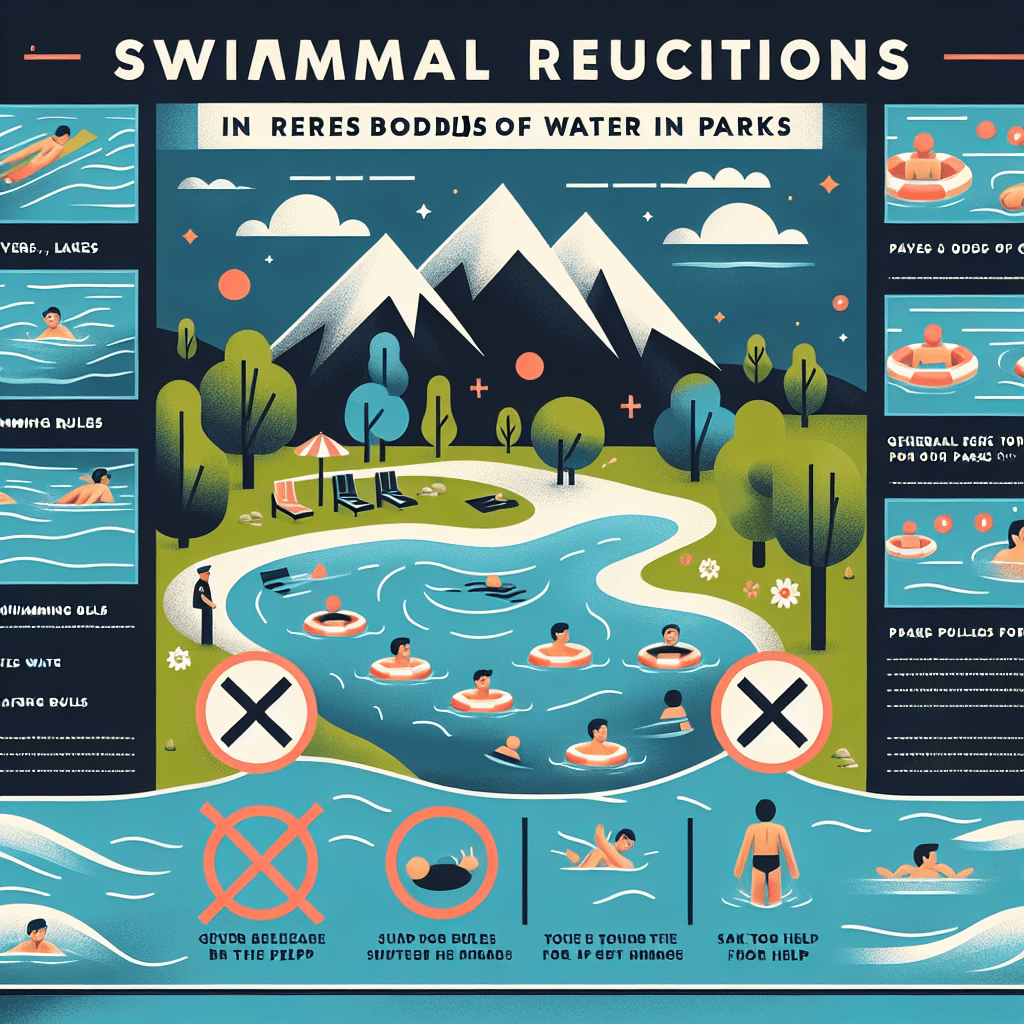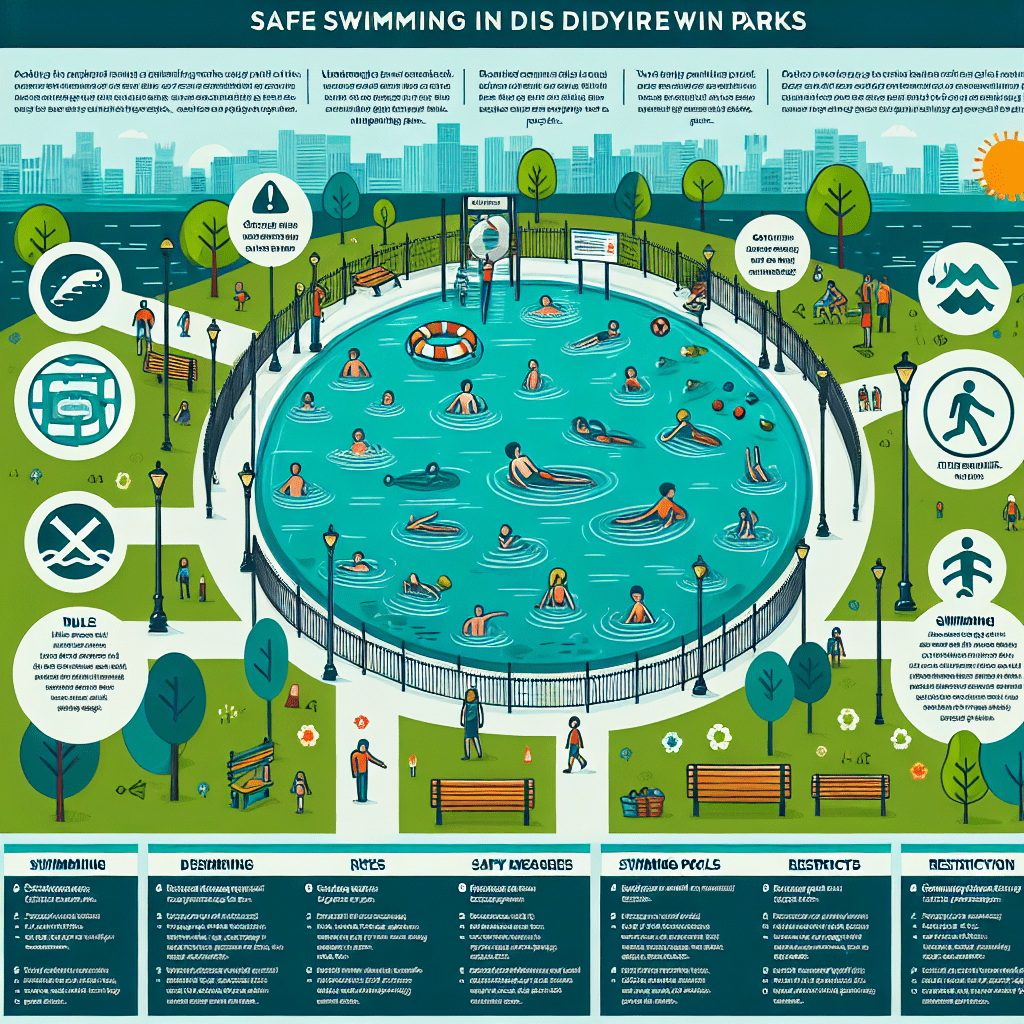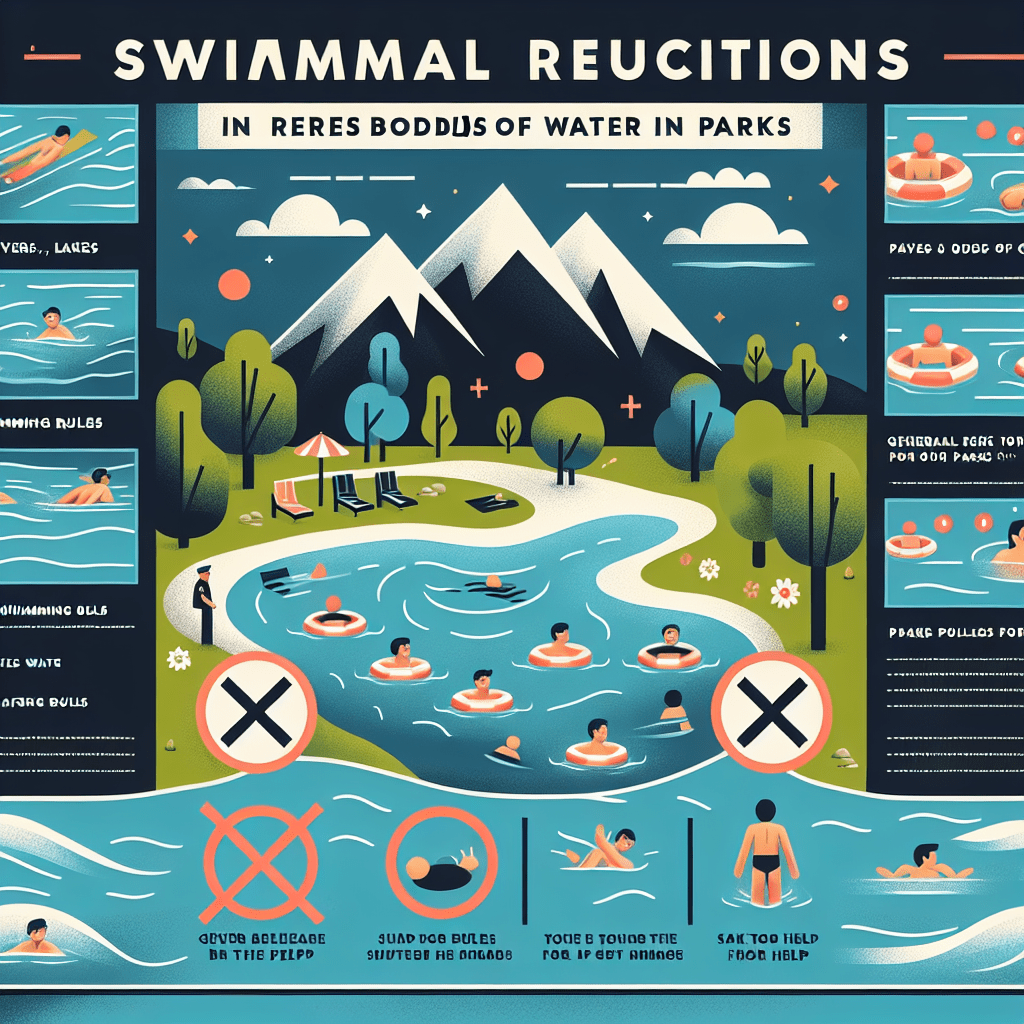
We bet you’re eager to take a refreshing dip in the park’s serene bodies of water, so we’re here to give you the scoop! In this article, we’ll explore the thrilling question on everyone’s mind: is swimming allowed in any of the park’s bodies of water? So, grab your towel and sunscreen as we navigate the waters to uncover the truth behind this watery wonderland.
Overview of the Park’s Bodies of Water
Types of bodies of water in the park
The park boasts a diverse range of bodies of water, catering to various preferences and interests of visitors. From calm and scenic lakes to rushing rivers and peaceful ponds, there is something for everyone. Additionally, the park offers access to several swimming areas, specially designated for those looking to cool off and enjoy a refreshing swim.
Size and depth of the bodies of water
The bodies of water within the park vary in terms of size and depth. Some lakes are expansive, offering ample space for swimming, while others are smaller and more secluded, providing a tranquil atmosphere for those seeking a quieter experience. The depths of the bodies of water also differ, with some being shallow and suitable for all ages, while others may have deeper sections for more experienced swimmers.
Flora and fauna in the bodies of water
The bodies of water in the park support a rich ecosystem of flora and fauna. Aquatic plants, such as lily pads, water lilies, and various types of algae, thrive in these waters, providing a picturesque backdrop to any swimming experience. Visitors may also have the opportunity to observe a variety of aquatic creatures, including fish, turtles, and waterfowl.
Park Rules and Regulations
General guidelines for park visitors
To ensure the safety and enjoyment of all park visitors, it is essential to follow the general guidelines set forth by the park administration. These guidelines include respecting the natural environment by disposing of trash properly, refraining from disturbing the wildlife, and staying on designated trails. Visitors are also encouraged to be mindful of noise levels to maintain the tranquility of the park.
Specific rules regarding swimming
While swimming is permitted in certain designated areas, it is essential to abide by specific rules and regulations to ensure the safety of all swimmers. Visitors must refrain from diving in shallow waters and pay attention to any warning signs or markers indicating potential hazards. Furthermore, visitors are advised to swim with a buddy and avoid venturing too far from shore, especially in areas with stronger currents.
Safety measures and lifeguard services
To enhance the safety of swimmers, the park implements various safety measures and provides lifeguard services in designated swimming areas. Trained lifeguards are stationed in these areas to closely monitor swimmers, respond to emergencies, and provide assistance when necessary. It is crucial for visitors to heed the lifeguards’ instructions and cooperate in maintaining a safe and enjoyable swimming environment.

Designated Swimming Areas
List of bodies of water with designated swimming areas
The park offers several bodies of water with designated swimming areas where visitors can safely enjoy a refreshing swim. These areas include Lake Harmony, Crystal Cove, and Meadow Springs Pond, among others. Each swimming area provides a unique experience, from the pristine waters of Lake Harmony to the family-friendly atmosphere of Crystal Cove.
Description of amenities at each swimming area
Swimming areas in the park are accompanied by a range of amenities to enhance visitors’ enjoyment and comfort. These amenities may include picnic tables and benches for relaxation, restroom facilities for convenience, and changing rooms for swimmers to prepare or change in and out of swimwear. Some areas may also have concessions or snack bars nearby, allowing visitors to hydrate and refuel after a swim.
Possible restrictions or requirements
Certain swimming areas in the park may have specific restrictions or requirements to ensure the well-being of both swimmers and the surrounding environment. These may include age restrictions, where certain areas are designated for adults or older children only, while others are more suitable for families with young children. Additionally, some swimming areas may require visitors to wear a life jacket, particularly in sections with deeper waters or stronger currents.
Condition of the Water
Water quality tests and monitoring
The park proactively monitors the water quality in its bodies of water to ensure the safety and cleanliness of the swimming areas. Regular water quality tests are conducted to assess factors such as bacteria levels, pH balance, and clarity. These tests play a crucial role in maintaining a healthy aquatic environment for both visitors and the park’s diverse wildlife.
Factors affecting water conditions
Several factors can influence the conditions of the water in the park’s bodies of water. Rainfall and temperature fluctuations can impact water levels and clarity, while the presence of natural elements and organisms, such as algae, may affect water quality. The park closely monitors these factors and takes necessary actions, such as implementing water treatment measures or temporarily closing swimming areas, to address any adverse conditions.
Regular maintenance and cleanliness
The park places great emphasis on regular maintenance and cleanliness of its bodies of water. This includes removing any debris or foreign objects that may accumulate, regularly inspecting and cleaning facilities such as changing rooms and restrooms, and addressing any potential safety hazards promptly. By maintaining the cleanliness and upkeep of the swimming areas, the park ensures a safe and enjoyable experience for all visitors.

Hazards and Risks
Common hazards in the bodies of water
While the park strives to provide a safe environment, it is essential for visitors to be aware of potential hazards in the bodies of water. Common hazards may include submerged rocks or tree branches, sudden changes in water depth, and unpredictable currents. Visitors should exercise caution, especially in unfamiliar waters, and consider wearing appropriate footwear to protect their feet from any underwater hazards.
Environmental risks and wildlife encounters
As a haven for biodiversity, the park’s bodies of water are home to various wildlife species. While encountering wildlife can be a fascinating experience, visitors should exercise caution and maintain a safe distance to avoid any potential risks. Depending on the location and time of year, there may be specific guidelines in place to ensure both visitor safety and the protection of the wildlife and their habitats.
Safety precautions for swimmers
To mitigate risks while swimming, swimmers are encouraged to take certain safety precautions. These include swimming within designated areas, staying close to shore, and avoiding swimming alone. It is also advisable to educate oneself about proper swimming techniques, such as swimming parallel to the shore in the case of a current, and being mindful of one’s own swimming abilities.
Activities Allowed in the Bodies of Water
Other recreational activities permitted
Apart from swimming, the park offers an array of other recreational activities in and around the bodies of water. These activities include kayaking, canoeing, and paddleboarding, allowing visitors to explore the waters while enjoying a different perspective of the park’s natural beauty. Fishing is also permitted in certain areas, subject to specific regulations and licensing requirements.
Water sports and equipment rentals
For those seeking a more exhilarating experience, the park provides opportunities for water sports such as jet skiing, waterskiing, and wakeboarding. Visitors can rent equipment on-site or bring their own for an action-packed day on the water. It is essential to adhere to any rules or guidelines set forth by the park to maintain a safe and enjoyable environment for all water sports enthusiasts.
Restrictions on boating and fishing
While boating and fishing are allowed in certain areas of the park, there may be restrictions in place to prioritize the safety of swimmers and protect sensitive ecosystems. Speed limits, no-wake zones, and fishing catch limits may be enforced to ensure responsible and sustainable use of the bodies of water. It is crucial for visitors to familiarize themselves with these restrictions and regulations before engaging in these activities.
Alternatives to Swimming
Non-swimming activities available in the park
For visitors who prefer not to swim, the park offers a variety of non-swimming activities to enjoy the natural surroundings. Hiking and nature trails provide opportunities to explore the park’s diverse flora and fauna on land. Birdwatching enthusiasts can indulge in spotting a wide range of bird species, while photography enthusiasts can capture stunning landscapes and wildlife in their natural habitat.
Waterfront picnic areas and scenic spots
For a relaxing day out, the park provides several picturesque waterfront picnic areas. These areas are ideal for enjoying a leisurely meal while taking in the scenic beauty of the bodies of water. Visitors can gather with family or friends, lay out a picnic blanket, and savor the tranquility of the park’s serene ambiance. These areas also provide excellent opportunities for wildlife observation.
Indoor swimming options nearby
In the event that swimming is not possible due to weather conditions or closures, there are indoor swimming options available in the vicinity of the park. Local indoor pools and aquatic centers provide an alternative for those seeking a swimming experience. It is advisable to inquire about operating hours, fees, and any specific COVID-19 safety protocols before visiting these indoor facilities.
Seasonal Considerations
Availability of swimming during different seasons
The availability of swimming in the park’s bodies of water may vary depending on the season. While swimming is typically allowed during warmer months when water temperatures are suitable for recreational activities, it is essential to check the park’s website or contact the visitor center for the most up-to-date information on swimming availability. Factors such as weather conditions and water quality may impact the opening and closing of swimming areas.
Weather-related restrictions or closures
In the interest of visitor safety, the park may implement weather-related restrictions or closures. Inclement weather, such as thunderstorms, heavy rainfall, or extreme heat, can pose risks to swimmers and may result in temporary closures of swimming areas. Visitors are encouraged to stay informed about any weather advisories and regulations imposed by the park to ensure a safe and enjoyable visit.
Off-peak and peak swimming periods
During peak swimming periods, such as weekends, holidays, and summer vacation months, the park’s designated swimming areas may experience higher volumes of visitors. This can result in limited parking availability and increased wait times at amenities such as changing rooms or restrooms. Visitors looking for a quieter experience may prefer to visit the park during off-peak periods, such as weekdays or during spring and fall seasons when the weather is still pleasant.
Education and Awareness Programs
Water safety programs for visitors
The park is committed to promoting water safety and offers educational programs to enhance visitors’ awareness of potential risks and precautions while swimming. These programs may include water safety workshops, interactive demonstrations, and informative brochures. By educating visitors about water safety, the park aims to empower individuals to make informed decisions and enjoy their swimming experience responsibly.
Educational events and workshops
In addition to water safety programs, the park hosts a variety of educational events and workshops to engage visitors in learning about the park’s natural resources and conservation efforts. These events may include guided nature walks, wildlife talks, and hands-on activities for all ages. By fostering a sense of connection and appreciation for the environment, the park aims to inspire visitors to become stewards of nature.
Conservation and preservation initiatives
As custodians of the park’s bodies of water, the park’s administration actively participates in conservation and preservation initiatives. These initiatives may include watershed protection programs, invasive species management, and water quality improvement projects. By implementing these measures, the park ensures the long-term health and sustainability of its bodies of water, providing future generations with the opportunity to enjoy these natural treasures.
Contact Information and Additional Resources
Park administration and visitor center contact details
For any inquiries or assistance, visitors can contact the park administration or visit the park’s visitor center. Park administration contact details, including phone numbers and email addresses, are available on the park’s official website. The visitor center is a valuable resource for obtaining maps, brochures, and up-to-date information on swimming regulations, events, and other park-related activities.
Online resources for park information
The park’s official website serves as an excellent online resource for obtaining comprehensive information about the bodies of water, swimming areas, park rules, and regulations. Visitors can access detailed maps, view frequently asked questions, and learn about upcoming events or workshops. The website also provides links to additional educational materials, safety tips, and guidelines for responsible use of the bodies of water.
Updates on swimming regulations
Given the dynamic nature of swimming regulations, it is essential for visitors to stay informed about any updates or changes. The park’s website is regularly updated with the latest information on swimming regulations, including any changes to designated swimming areas, safety measures, or closures. Visitors are encouraged to check the website or contact the visitor center closer to their planned visit for the most accurate and up-to-date information.